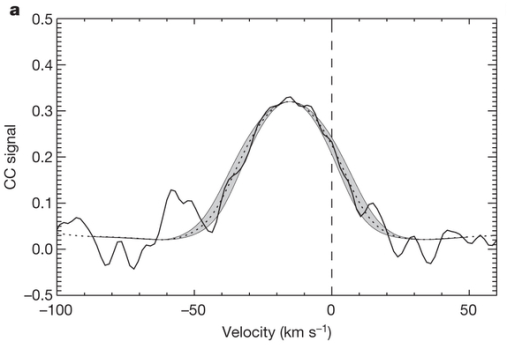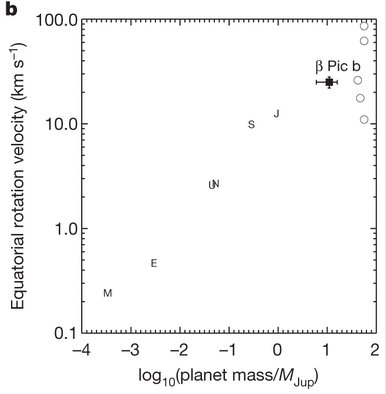Astronomers have determined the length of a day on an exoplanet for the first time. While over 1000 exoplanets have been discovered and characterised, none have yet had their rotation rates measured.
Most exoplanets that we know of have been detected in an indirect way, by measuring the effects the unseen planet has on the star it orbits. Exoplanet are discovered by either measuring the “wobble” of the star due to the gravitational perturbations of the planet, or by measuring the dimming of light as the unseen planet passes in front of the bright star and blocks some of the light. However, some exoplanets, like β Pictoris b, have been directly detected, meaning astronomers observe the light coming from the planet itself. It is easiest to directly detect young, massive planets that are not too close to their host star. The further the planet is from its host star, the easier it is to distinguish the light from the planet (which is extremely faint compared to the bright star). Young planets still contain a large amount of heat left over from their formation, which makes them relatively big and puffed up. The more massive a young planet is, the warmer and hence brighter it will be, making it easier to detect at infrared wavelengths.

Three infrared observations over 7 years of the exoplanet β Pic b. The light from the central star is blocked out, but the stellar location marked. The planet has moved to the other side of the star from 2003 to 2009, and its motion is clearly seen from October 2009 to March 2010. (Credit: Bonnefoy et al. 2011, Astronomy & Astrophysics)
While these images clearly show the motion of the planet, they cannot tell us the direction of the planet’s motion. Using near-infrared high-dispersion spectroscopy with the help of the CRIRES instrument on the Very large Telescope in Chile, Ignas Snellen and collaborators have determined the orbital and rotational velocity of the planet orbiting β Pic. The CRIRES spectrograph uses a diffraction grating to break the infrared light up into its component wavelengths so that astronomers can target specific spectral lines. Snellen’s team targeted molecules produced in the cool atmospheres of giant planets (which include water, carbon monoxide, methane and ammonia). The spectral lines from these molecules, which are found in the near-infrared part of the electromagnetic spectrum, are quite distinct from the relatively smooth spectrum of the star. The atmosphere of the star is much hotter than that of the planet – especially for a large, hot A-type star like β Pic – and it contains only a few atomic spectral lines rather than molecular lines.
The spectrum of the planet is shifted in wavelength by an amount that depends on the orbital speed and inclination of the planet’s orbit, and the spectral line will also be broadened by an amount the depends on the rotation speed of the planet. As the planet rotate, half of the planet appears to be moving toward us, which shifts the spectral lines towards to blue, while the other half of the planet appears to be moving away from us, shifting the spectral lines towards to red. These two effects combine and make the spectral lines both broader and shallower. Snellen et al. found that the CO spectral lines of the planet was broad and blueshifted. By studying the position and shape of the spectral lines and comparing them to model spectra with different planetary rotation rates and spin axis inclinations (planetary “obliquity”), they calculated that the rotation rate must be at least 25 km/s. The diameter of β Pic b is thought to be about 1.6 times that of Jupiter, which implies that a day on β Pic b lasts for 8 hours. The blueshifted spectra indicates that the planet is currently on a part of its orbit that is moving towards the Earth.

Spectral signal of β Pic b, which is rotationally broadened by 25 km/s, and also blueshifted with respect to the velocity of the host star, indicating that the planet is currently moving towards the Earth on its orbit. (Credit: Snellen et al. 2014, Nature, 509, 63)
The equatorial rotation rate of 25 km/s of β Pic b fits in quite well with the “mass-spin relation” we see for the planets of our Solar System, where the rotation rate increases with planetary mass. The exact origin of this relation is not clear, but is likely due to planet formation. While the rocky terrestrials and gas giant planets follow different formation paths, all planets grow by the accretion of impacting bodies which add their angular momentum, or spin, to the growing planet. The larger the planet, the more impacting bodies it will have accreted and this could explain why more massive planets have faster spin rates. Given that β Pic b is still a young and hot planet, as it slowly cools it will contract, which will speed up its rotation rate (due to conservation of angular momentum). Over the next few hundred million years, the length of a day on β Pic b is expected to shorten to about 3 hours.

Rotation rate versus mass for the planets in our Solar System, plus β Pic b. Mercury and Venus do not fit this relation as they have been spun down due to tidal interaction with the Sun. (Credit: Snellen et al. 2014, Nature, 509, 63)
As number of exoplants that are directly detected increases, this technique will help astronomer investigate the spin-mass relation on other planets, as well as study the weather systems on exoplanets. The rapid rotation rates of the giant planets in our Solar System dominate their weather systems, which is most likely true on β Pic b as well.
For more information, see
- Length of Exoplanet Day Measured for First Time, ESO press release
- First exoplanet seen spinning, Ron Cowen, Nature News
- Fast spin of the young extrasolar planet β Pictoris b, Snellen et al. (2014), Nature, 509, 63 [Swinburne login required]
- Astronomy: A new spin on exoplanets, Travis Barman, Nature News & Views
[Sarah Maddison]
